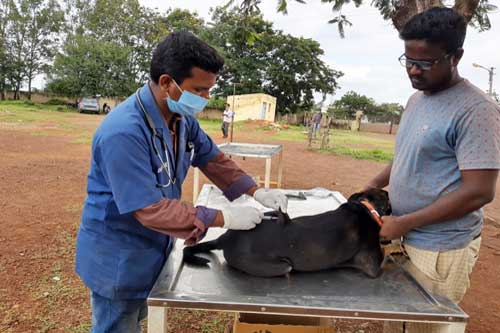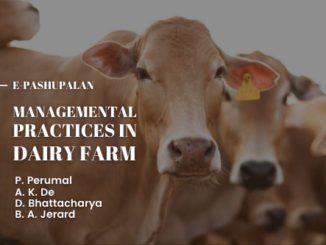Value of vaccination is the theme for the celebration of world veterinary day 2019 by World veterinary association (WVA). This shows the importance of vaccination in veterinary practices. The term vaccination coined by Edward Jenner in 1798, who is known as father of Immunology. The word vaccination derived from Latin word Vacca means Cow. He showed that people with cowpox are immune to smallpox and prepared small pox vaccine from cow pox extract. WHO defines vaccination as immunization is the process whereby a person is made immune or resistant to an infectious disease, typically by the administration of a vaccination. Vaccines stimulate the body’s own immune system to protect the person against subsequent infection or disease. OIE defines vaccination is the administration of a vaccine in accordance with the manufacturer’s instructions and the Terrestrial Manual, when relevant, with the intension of inducing immunity in an animal or group of animals against one or more pathogen agents. Wikipedia defines vaccination is the administration of a vaccine to help the immune system develop protection from a disease. When vaccine containing the organism or the antigen is administered subcutaneously or intramuscularly will elicit an immune response and will give protection. Vaccine contains a microorganism or virus in a weakened, live or killed state or proteins or toxins from the organisms which is given at prescribed time and age, which will protect from the prescribed infection by producing the antibodies. Louis Pasteur developed vaccines against Fowl Cholera, Anthrax and Rabies. Polio vaccine in human and Render pest vaccine in animal has a great contribution in terms of disease eradication. Vaccine discovery is great mile stone in human as well as animal health programmes.

Importance of vaccination
- Vaccination will helps in disease eradication. Example : RP Vaccination
- Vaccination will reduce the suffering of animals in terms of disease outbreak with high morbidity and mortality. Example: Foot and mouth disease.
- Vaccination will protect the health of individual animal from a particular disease at a given time. Example: HS Vaccine given prior to monsoon to control the outbreak in monsoon.
- Vaccination will improve the animal welfare by reducing the incidence and suffering from the disease. Example: BQ Vaccine.
- Vaccination will reduce the disease incidence, as a result improves health and productivity of animal. Example: ET Vaccination in Sheep and Goat.
- Vaccination acts as tool in control of disease. Example : HS and BQ Diseases out break
- Vaccination acts as a control measure in outbreak of some of disease in terms of Ring vaccination. Example: FMD outbreak.
- Vaccination helps in control of zoonotic diseases. Example: Rabies.
- Vaccination helps in control of disease in pets and birds. Example: RKT Vaccine in birds.
- Regular vaccination programmes will reduce the severe economical losses from the deadly diseases like Black quarter and Anthrax in dairy industry in terms of morbidity, treatment expenses and mortality.
- Vaccination will helps in buildup the herd immunity. Example: Foot and mouth disease.
- Vaccination will helps in control of emerging and exotic diseases. Example: Lumpy skin disease in Cattle.
- Vaccination will reduce the usage of Chemotherapeutic agents thereby reduce the cost of production in livestock industry. Example: HS and BQ Vaccine.
- Vaccination will be the cost effective method in disease control and management practices.
- Vaccination will promotes international trade.
- Vaccination will helps in economical stability in livestock industry.

Classification of vaccines used in veterinary practices
- Live attenuated vaccines
- Killed or inactivated vaccines
- Sub unit vaccines
- Toxoids`
1. Live attenuated vaccine
As the name itself indicates here the disease causing live pathogen will be attenuated by continuously passaging in different medium to remove the disease causing ability and to retain the immunogenicity. The process of reduction of virulence is called as attenuation.
Example: Sterne’s strain of Anthrax spore vaccine, Cotton strain 19 Brucella vaccine.
Advantages
- Live attenuated vaccines will produce both humoral and cell mediated immunity.
- Live vaccines also produces good amount of IgG and Interferon (IFN).
- Immunity produced will have long period.
- Booster dose is not necessary.
Disadvantages
- In stress vaccine may causes disease.
- Storage and transport of vaccination is difficult task.
- May cause disease if it’s given in wrong route.
- Sensitive to improper handling/storage.
2. Killed or inactivated vaccine
Contain inactivated whole organism or portion of organism, generally combined with an adjuvant. They need booster dose for effective protection. Here total organism or part of organism is used to stimulate the immune response. Here adjuvant like Alumenium\ Hydroxide widely used to enhance the duration of immunity and antibody titer.
Example: HS vaccine.
Advantages
- No chance of getting infection even though animal is in stress
- Vaccine transport and storage is easy.
Disadvantages
- Cell mediated immune response will not be satisfactory.
- Immunity developed will not last long period.
- IgG and Interferon production will not be satisfactory.
- Booster dose is needed.
3. Sub unit vaccine
Here the part component of organism used as vaccine not whole organism. Component like protein, sugar, capsid of the organism used to induce the strong immune response.
Example: VP-1 Vaccine for Foot and mouth disease.
Advantages
- Vaccine is stable and safe.
- Undesirable effects due to vaccine will be less.
Disadvantages:
- Cost of production will be more.
- Chance of vaccine failures is possible.
Toxoids
Here toxins from bacteria after treating with some chemicals or heat treatment, so that to remove the toxicity and to retain the immunogenicity.
Example: Tetanus toxoid.
Advantages
- Vaccine will not cause infection.
- They will generate strong immune response.
Disadvantages
- Toxoids may cause severe allergy.
- They may cause neurological disorders.
Other types of vaccinations are
- Adjuvant vaccines.
- Combination vaccines.
- Marker vaccine.
- Recombinant vaccine.
Precautions to be taken during vaccination/vaccination programme
- Deworming is advised before one week prior to vaccination will have better efficacy.
- Read the manufacturer advice/leaflet before vaccination.
- Use separate needles to each animal during vaccination to avoid the possible iatrogenic transmission of diseases like Anaplasmosis and Lumpy skin disease.
- Vaccination should be done in early morning or in late evening to avoid the unnecessary complications arising due to adverse climatic exposure.
- Sick and very young animals should not be vaccinated.
- After vaccination animal should be monitored for 30 minutes to 1 hour for any adverse effects.
- Emergency medicine kit including medicines like anti-histamines, Corticosteroids, Fluids and anti-inflammatory should be kept ready with vaccination kit.
- Diluents, dosage, route of administration, usage in pregnancy and lactation should be strictly followed as per the manufacturer instructions.
- Animal with pyrexia, trauma, recently underwent major surgery, immune compromised will not be vaccinated.
- Vaccination programme should not be kept on adverse climate conditions like heavy rainy day, hot and humid sunny day, snow falling day.
- Avoid vaccination to immune-suppressed, stressed, exhausted and late pregnant animals.
- Proper restraining should be followed before vaccination to ensure safety to animals as well as vaccinator.

Adverse effects of vaccination
Swelling at the site of administration, Urticaria or allergic reactions on skin, abortion in female animals, swelling of eye balls and ears, facial swelling, systemic signs like fever, vomition and or diarrhea. Sometimes anaphylaxis, shock, collapse, and death
Routes of vaccination delivery
- Parentral injection
- Needle – free
- Intranasal
- Ocular
- Oral
- Spray/Topical
Vaccination Schedule for Cattle
|
SN
|
Name of the disease and vaccine | Age of animal for the first time of vaccination | Type of vaccine | Dose | Route |
Duration of immunity |
| 1 | Anthrax Stern’s spore vaccine | After 6 months of age | Live avirulant | 1ml | SC | Annually in endemic area. |
| 2 | Brucellosis Cotton 19 strain vaccine | For only in female calves/ | Live | 5ml | SC | Once in a life time. |
| 3 | Black quarter Formalized | After 6 months of age | Killed | 5ml | SC | Annually in endemic area. |
| 4 | Foot and mouth disease-Oil adjuvant vaccine | After 6 months of age | Polyvalent | 2ml | IM | Every six month. |
| 4 | Hemorrhagic Septicemia Formalized | After 6 months of age | Killed | 5ml | SC | Annually in endemic area. |
| 5 | Rabies (Pre bite) | After 6 months of age
|
Killed | 1ml | IM | Annually in endemic area.
Post bite vaccination schedule 0,3,7,14,28 and 90 days. |
| 6 | Thelieriosis-Schizant vaccine
|
After 3-4 months of age | Live | 3ml | SC | Once in a life time, given to cross breed cattle. |
| 7 | Lumpy skin disease Uttar kashi strain goat pox vaccine
|
After 4 months of age | Live | 2 ml | SC | Annually in endemic area. |

Vaccine schedule for Sheep and Goat
|
SN |
Name of the Vaccine | Age of the animal at the first time of vaccination | Type of vaccine |
Dose |
Route |
Duration of immunity |
| 1 | Enterotoxaemia ET Vaccine | After 4 months of age | Killed | 1ml | SC | Biannual in endemic area. |
| 2 | Black quarter BQ Vaccine | After 6 months of age | Killed | 2.5ml | SC | Annually in endemic area. |
| 3 | Hemorrhagic Septicemia HS | After 6 months of age | Killed | 2.5ml | SC | Annually in endemic area. |
| 4 | Blue Tongue
BT Vaccine |
After 6 months of age | Live | 3ml | SC | Annually in endemic area. |
| 5 | Foot and mouth disease
FMD Vaccine |
After 6 months of age | cell culture |
1ml | IM | Every six month. |
| 6 | PPR
Live attenuated |
After 3 months of age | Live | 1ml | SC | Annually in endemic area. |
| 7 | Anthrax
Stern’s spore vaccine |
3 months and above | Live | 0.2ml | SC | Annually in endemic area. |
| 8 | Goat pox
Uttar kashi strain goat pox vaccine |
After 6 months of age | Live
|
1ml | SC | Annually in endemic area. |
| 9
|
Rabies
(Pre bite) |
3 months and above
|
Killed | 1ml | IM | Annually in endemic area. Post bite vaccination schedule 0,3,7,14,28 and 90 days |
| 10
|
Sheep pox
Live attenuated |
After 6 months of age | Live | 1ml | SC | Annually in endemic area. |

Vaccination schedule for pigs
|
SN |
Name of vaccine | Age of the animal at the first time of vaccination | Type of vaccine | Dose | Route |
Duration |
| 1 | Foot and mouth disease | After 6 months of age | Inactivated cell culture vaccine | 1ml | IM | Every six month. |
| 2 | Swine fever
|
After 4 months of age | Live | 1ml | IM | Annually in endemic area. |
| 3 | Porcine circo virus infection | After 3 weeks of age | Recombinant | 1ml | IM | Annually in endemic area |
Vaccination schedule for Dog
| SN | Name of disease | Name of vaccination | Age | Dose | Route |
| 1 | Canine distemper, Infectious canine hepatitis, Canine parvo virus, Canine Para influenza, Canine Corona virus. | DHPPi and Corona virus | 6-8 weeks | DHPPi-Primary
Corona-Primary |
IM |
| 2 | Canine distemper, Infectious canine hepatitis, Canine parvo/./ virus, Canine Para influenza, Canine Corona virus, Canine Leptospirosis | DHPPi +L
Corona virus |
10-12 weeks | DHPPi – Booster
Corona – Booster Leptospira- Primary |
IM |
| 3 | Canine distemper, Infectious canine hepatitis, Canine parvo virus, Canine Para influenza, Canine Corona virus, Canine Leptospirosis
Canine Rabies |
DHPPi +L
Corona virus Rabies |
12-16 weeks | DHPPi – Booster
Corona – Booster Leptospira- Booster Rabies – Primary |
IM |
| 4 | Canine distemper, Infectious canine hepatitis, Canine parvo virus, Canine Para influenza, Canine Corona virus, Canine Leptospirosis
Canine Rabies |
DHPPi +L
Corona virus Rabies |
1 year | DHPPi – Booster
Corona – Booster Leptospira- Booster Rabies – Booster |
IM |

Vaccination Schedule for Cats
|
SN |
Name of the diseases | Name of the vaccine
Dose |
Age |
Route |
| 1 | Feline viral rhinitrachetis(FVR), Feline calcivirus and Feline panleukopenia(FPL) | FVRCP Primary
|
08-10 weeks | IM |
| 2 | Feline viral rhinitrachetis(FVR), Feline calcivirus and Feline panleukopenia(FPL) | FVRCP First Booster
|
11-13 weeks | IM |
| 3 | Feline viral rhinitrachetis(FVR), Feline calcivirus and Feline panleukopenia (FPL)
Rabies
|
FVRCP second Booster Rabies Primary
|
14-16 weeks | IM |
| 4 | Rabies
|
Rabies Booster |
18-20 weeks | IM |
| 5 | Feline viral rhinitrachetis(FVR), Feline calcivirus and Feline panleukopenia(FPL) | FVRCP and Rabies annual Booster
|
1 year | IM |
Vaccination schedule for Broiler birds
| SN | Name of vaccine | Age and booster dose | Type of vaccine | Route |
| 1 | Marek’s disease
|
1 day | Live | IM |
| 2 | Ranikhet disease | 5-7 days
28 days |
Live | Spray/Occulonasal drops |
| 3 | Infectious bronchitis | 28 days | Live | Spray/drinking water |
| 4 | Infectious bursal disease | 14 days
35 days |
Live | Spray/drinking water |
Vaccination schedule for Layer birds
| SN | Name of vaccine | Age | Type of vaccine | Route |
| 1 | Marek’s disease
|
1 day | Live | IM |
| 2 | Ranikhet disease | 5-7 days
28 days 8 weeks 16-18 weeks
|
Live | Spray/Occulonasal drops/drinking water/SC/IM |
| 3 | Infectious bursal disease | 14 days
35 days
|
Live | drinking water |
| 4
|
Infectious bronchitis | 8 weeks
12 weeks 16-18 weeks |
Live
Killed Killed |
drinking water |
| 5
|
Infectious coryza | 3 weeks | Killed | drinking water |
| 6
|
EDS-76 | 16-18 weeks | Killed | Spray/drinking water |
| 7
|
ILT | 16 weeks | IM | |
| 8
|
Fowl pox | 42 days | Live |
Reasons for vaccination failures
- Stress.
- Poor immunity.
- Improper dose and route.
- Malnutrition.
- Poor quality vaccine.
- Improper vaccine storage/breaking of cold storage.
- Improper handling of vaccine.
- Vaccine exposure to sunlight.
- Animal already in incubation period of disease.
- Improper mixing of vaccine.

Need of the hour
Every year in India thousands of livestock will die due to various diseases. So information and awareness related to vaccines importance and its usage in animals should reach to farmers. Field veterinarians and institutes related to animal husbandry and veterinary services should work on this direction to save the life of animals and to promote the farmers and nation’s economy.
References
- Epidemiology Notes by Dr Prasanna Kumar Veterinary College Bidar, Karnataka
- Veterinary Immunology Basic concepts’ and applications by Y Hari Babu.
- Vaccination to prevent and protect: KVC Bangalore 2013
- Products Handbook: IAH&VB Bangalore
- Veterinary vaccines and their importance to animal health and public health: James A Roth
- Wikipedia







Complete information on vaccination.
Nic article sir